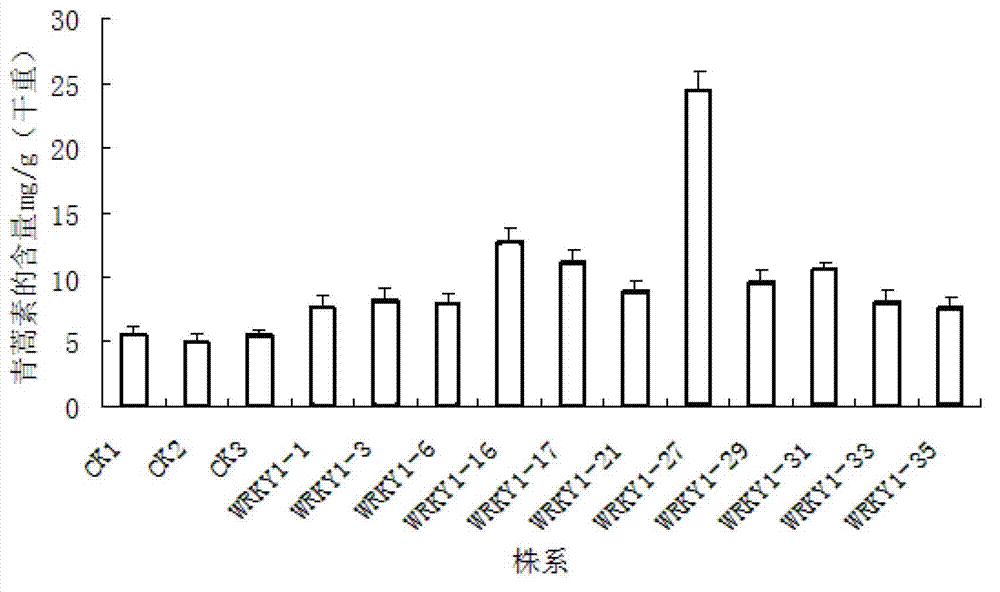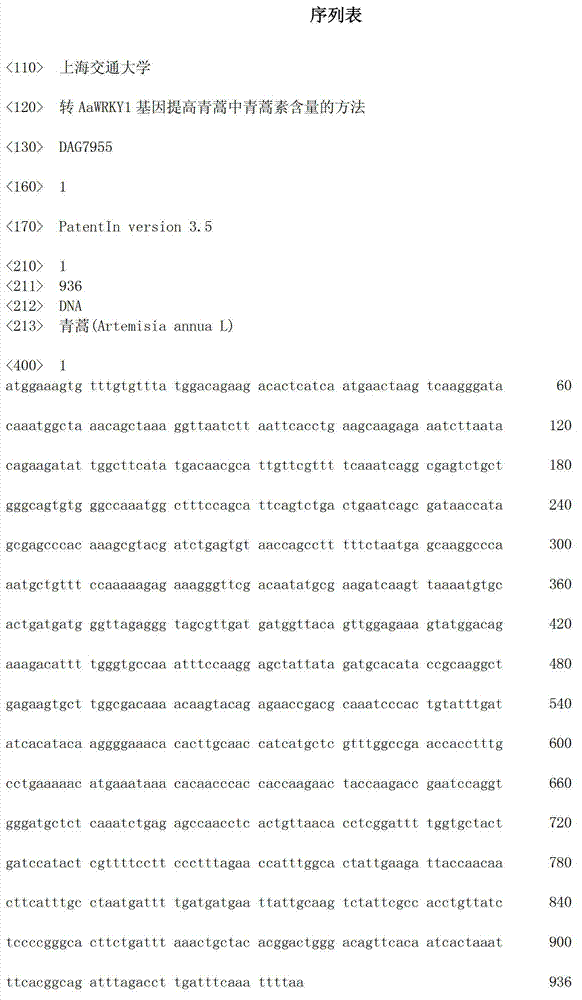Method for increasing artemisinin content of sweet wormwood by transferring AaWRKY1 gene
A kind of artemisinin and transgenic technology, applied in genetic engineering, plant genetic improvement, botanical equipment and methods, etc., can solve the problem of low artemisinin content, large-scale commercial production restrictions, and low feasibility of artemisinin problem, to achieve the effect of increasing the content of artemisinin
- Summary
- Abstract
- Description
- Claims
- Application Information
AI Technical Summary
Problems solved by technology
Method used
Image
Examples
Embodiment 1
[0026] Cloning of AaWRKY1 Gene of Artemisia annua
[0027] 1.1 Extraction of total RNA from Artemisia annua genome
[0028] Take 100-200mg young leaves of Artemisia annua, quick-freeze them with liquid nitrogen, grind them quickly with a mortar, add them into a 1.5mL Eppendorf tube filled with 1mL TRlzol (TRlzol Reagents, GIBCOBRL, USA), shake them fully, and place them at room temperature Stand for 5 minutes, add 200 μL of chloroform, shake vigorously for 15 sec, place at room temperature for 2-3 minutes, then centrifuge at 12,000 rpm for 15 minutes at 4°C; suck the supernatant (about 600 μL) into a clean 1.5 mL Eppendorf tube, add an equal volume of isopropyl Alcohol, mix it upside down, place it at room temperature for 10 minutes, then centrifuge at 12,000rmp for 10min at 4°C; discard the supernatant, add 1mL of 75% ethanol to wash, shake, and centrifuge at 7,500rmp for 5min at 4°C; dry at room temperature for 10-15min and dissolve In an appropriate amount (30-40 μL) of RN...
Embodiment 2
[0033] Construction of Plant Binary Expression Vector Containing AaWRKY1 Gene
[0034] 2.1 Construction of intermediate vector pMD18T-AaWRKY1
[0035]The pMD18T-simple vector (Takara, Dalian) was selected as the basic element to construct the intermediate vector pMD18T-AaWRKY1. Specifically, the full length of the gene with KpnI and SacI restriction sites introduced before and after the AaWRKY1 gene was amplified by high-fidelity enzymes, connected to the pMD18T vector by ligase, and the correctness of the gene was confirmed by Shanghai Invitrogen Company sequencing.
[0036] 2.2 Construction of plant expression vector FSN::p35S-AaWRKY1-NOS
[0037] Using the FSN (FSN expression vector transformed from the pCAMBIA2300 expression vector) as the expression vector, the AaWRKY1 gene in Example 1 was connected to its corresponding restriction site. Specifically, KpnI and SacI double-digested the intermediate vector pMD18T-AaWRKY1 and the expression vector FSN. The AaWRKY1 gene f...
Embodiment 3
[0040] Agrobacterium tumefaciens mediated AaWRKY1 gene genetic transformation of Artemisia annua to obtain transgenic Artemisia annua plants
[0041] 3.1 Obtaining the AaWRKY1 gene-containing binary plant expression vector Agrobacterium tumefaciens engineering bacteria
[0042] The plant binary expression vector containing the AaWRKY1 gene in Example 2 was transformed into Agrobacterium tumefaciens (such as EHA105, which is a publicly available biological material in the market, which can be purchased from CAMBIA Company in Australia, and the strain number is Gambar1), and PCR was carried out verify.
[0043] 3.2 Agrobacterium tumefaciens mediated AaWRKY1 gene transformation of Artemisia annua
[0044] (1) Pre-cultivation of explants
[0045] Artemisia annua seeds were soaked in 75% ethanol for 1 min, then soaked in 20% NaClO for 20 min, rinsed with sterile water for 3 to 4 times, blotted the surface water with sterile absorbent paper, and inoculated in hormone-free MS (Mura...
PUM
 Login to View More
Login to View More Abstract
Description
Claims
Application Information
 Login to View More
Login to View More - R&D
- Intellectual Property
- Life Sciences
- Materials
- Tech Scout
- Unparalleled Data Quality
- Higher Quality Content
- 60% Fewer Hallucinations
Browse by: Latest US Patents, China's latest patents, Technical Efficacy Thesaurus, Application Domain, Technology Topic, Popular Technical Reports.
© 2025 PatSnap. All rights reserved.Legal|Privacy policy|Modern Slavery Act Transparency Statement|Sitemap|About US| Contact US: help@patsnap.com


